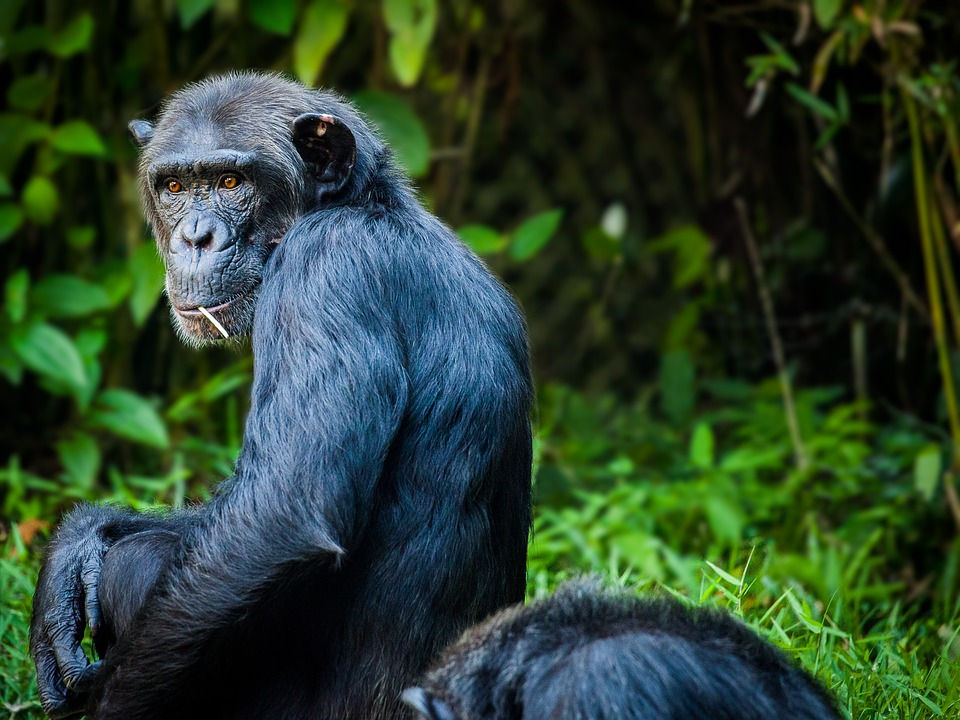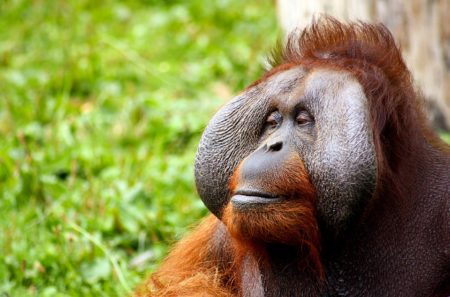Amazing Facts: 12 facts about apes
by Scott Dutfield · 23/07/2019

Get to know your closest animal relative
1. Apes are not monkeys
Although they are both primates, the last common ancestor of apes and monkeys lived around 25 million years ago. Apes are generally larger, they don’t have the tails that monkeys do, have a larger brain-to-body size ratio, and rely more on their eyesight than sense of smell. Apes also have more intricate social
structures and longer lifespans.
2. Bonobos are rare
Bonobos are one of the most rare primate species, only found in the lush rainforests of the Democratic Republic of Congo. There are a population of between 10,000–50,000 individuals left in the wild, spread across just a handful of populations.
3. Apes always make their beds
All great apes sleep in nests and show sophisticated building techniques, using the differing way that sticks and twigs snap and bend to build comfy sleeping dens. Apes make a new nest every night, as they rarely sleep in the same place twice. Silverback gorillas always make nests on the ground, but females and younger males prefer to sleep aloft. Orangutans, chimps and bonobos show the same building capabilities, choosing large forks in strong branches to build a nest that can support their weight, and then padding the nest out with smaller twigs and leaves for comfort. In a lifetime, a chimpanzee may construct over 19,000 nests!
4. Female bonobos rule society
Bonobos, unlike the rest of their great ape cousins, live in a matriarchal society. The females are the dominant sex; they are able to (peacefully) overpower the males to choose their own mates and claim the best food.
5. Orangutans are slow breeders
Orangutans are the slowest apes to reproduce; they live up to 45 years in the wild and have a baby every eight years. The young depend on their mothers for over five years
6. Some apes are great at maths
We have covered the great apes’ incredible use of tools that shows some truly outstanding and undeniable brainpower. But aside from this ability, just how clever are they? The answer is: very. Apes will never be able to speak because of the position of their larynxes, but that doesn’t mean they don’t understand language. A gorilla named Koko learnt a vocabulary of more than 1,000 words in American sign language and can use it to communicate. A bonobo called Kanzi even learnt to understand some spoken English the way that human children do, by being exposed to it from an early age. There are also orangutans that are maths wizards, chimpanzees that have beaten their human trainers at memory games, and bonobos that can drum along to a beat. And that’s just scratching the surface of what great apes can do. Just like in humans, cognitive abilities differ from one ape to the next. And in yet another parallel with us, it seems that this is in part due to their genes and in part due to their social structure and environmental influences: it’s the age-old nature/nurture debate.
7. Organutans: flanged or unflanged?
 Male orangutans can develop large facial pads known as flanges, but it’s not fully known why some males develop these and others don’t.
Male orangutans can develop large facial pads known as flanges, but it’s not fully known why some males develop these and others don’t.
8. Apes are under threat
As the world’s largest tree-climbing species, orangutans disperse seeds from their favourite foods, and help to maintain the health of the ecosystem for other forest inhabitants.
9. We share 99+ per cent of our DNA with chimps
Gorillas, chimpanzees, bonobos, orangutans and humans all belong to the family of primates called Hominidae. Based on genetic analysis, humans are more closely related to chimpanzees and bonobos, both sharing 99.6 per cent of our DNA. Gorillas share 98 per cent and orangutans share 97 per cent. However, although the similarities are striking, it’s that 0.4 per cent that has allowed us to advance so far past the evolution of the apes (bear in mind that we share almost 50 per cent of our DNA with fruit flies!)
Humans aren’t descended from any primate species that are still alive today. The common ancestor of chimps, humans and gorillas evolved around ten million years ago. At around six million years ago the lineage broke off that gave rise to modern humans and chimpanzees. Our closest African ape relatives were in the genus Pan, and likely looked chimp-like in appearance.
10. Apes have their own language
The great apes are a vocal bunch, and use a large vocabulary of sounds to communicate, including shrieks, hoots, roars and growls, as well as other more subtle noises.
11. Gorillas grin like us, but it’s not because they’re happy
Similar to the way we tell how fellow humans are feeling by assessing facial expressions, gorillas use an array of expressions to communicate with one another, along with gestures and vocalisations. One of the most easily recognised is the ‘play face’. This involves an open mouth but covered teeth; it’s non-threatening and means ‘I could bite you but I won’t’. Another is similar to the human smile, where all teeth are on show. We associate smiles with enjoyment, but this is a greeting or affiliation. Similarly, it’s often thought that when teeth are bared, this signifies aggression, but with gorillas this is only true if the mouth is open and ready to bite. If the teeth are pressed together, this is almost always a sign of submission. These expressions are combined with many other physical clues and vocal expressions to form a complex language.
12. There’s more than one type of gorilla
There are two species of gorilla, each of which is made up of two subspecies. They are all found in the tropical rainforests of Africa.
This article was originally published in How It Works issue 89, written by Ella Carter
For more science and technology articles, pick up the latest copy of How It Works from all good retailers or from our website now. If you have a tablet or smartphone, you can also download the digital version onto your iOS or Android device. To make sure you never miss an issue of How It Works magazine, subscribe today!




